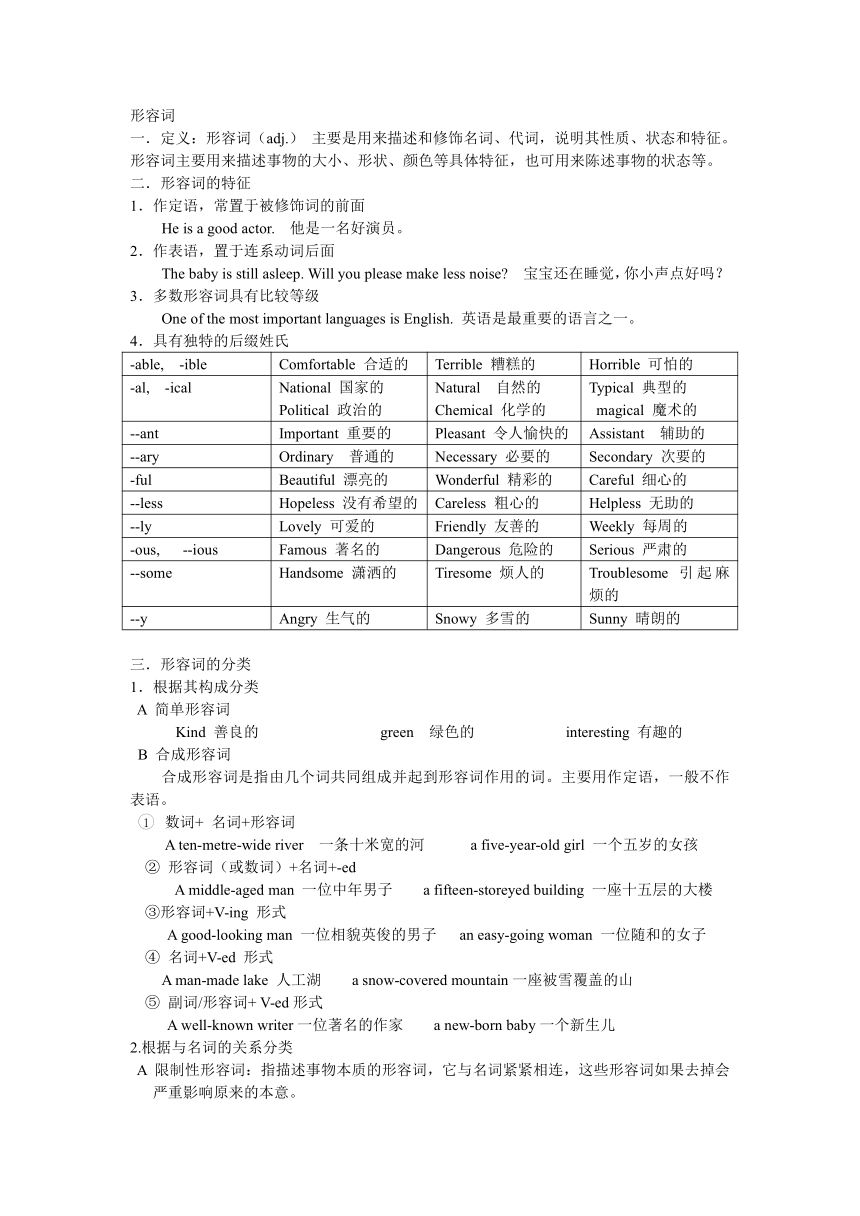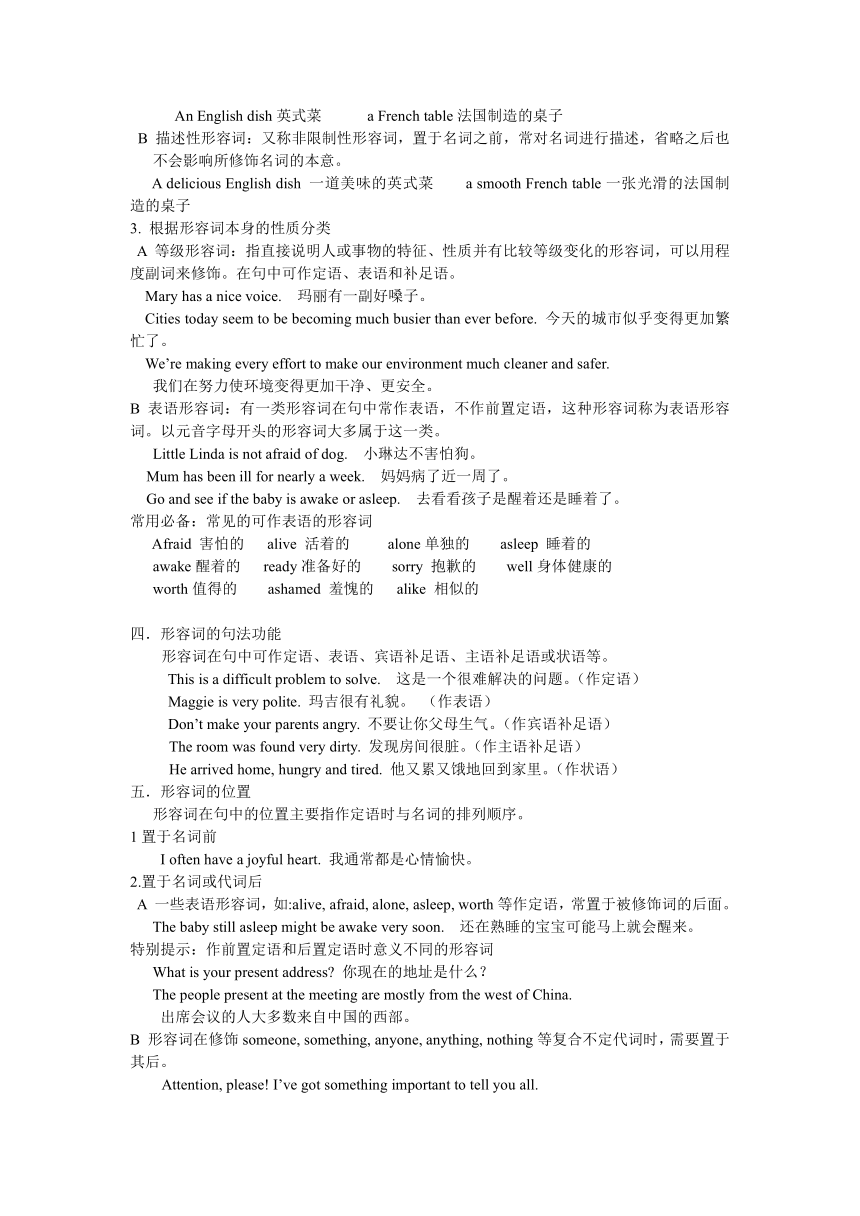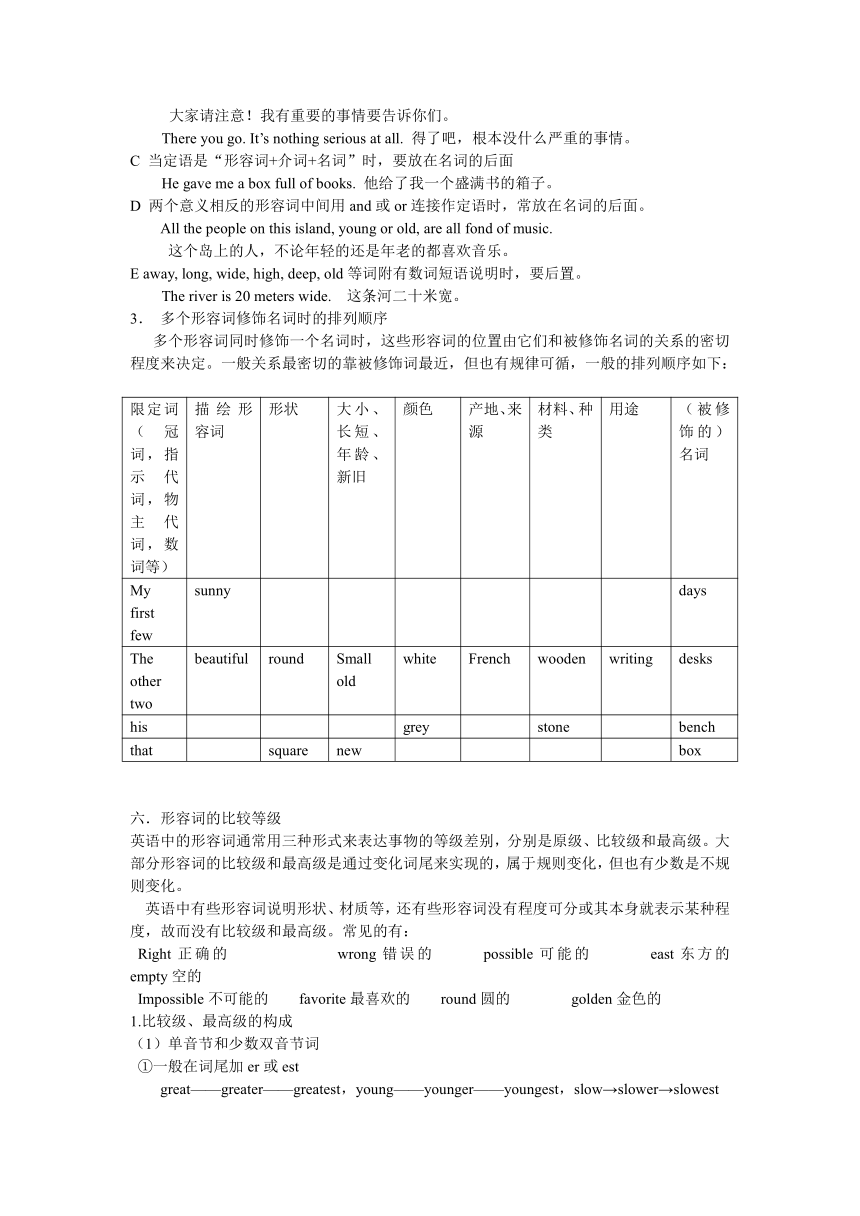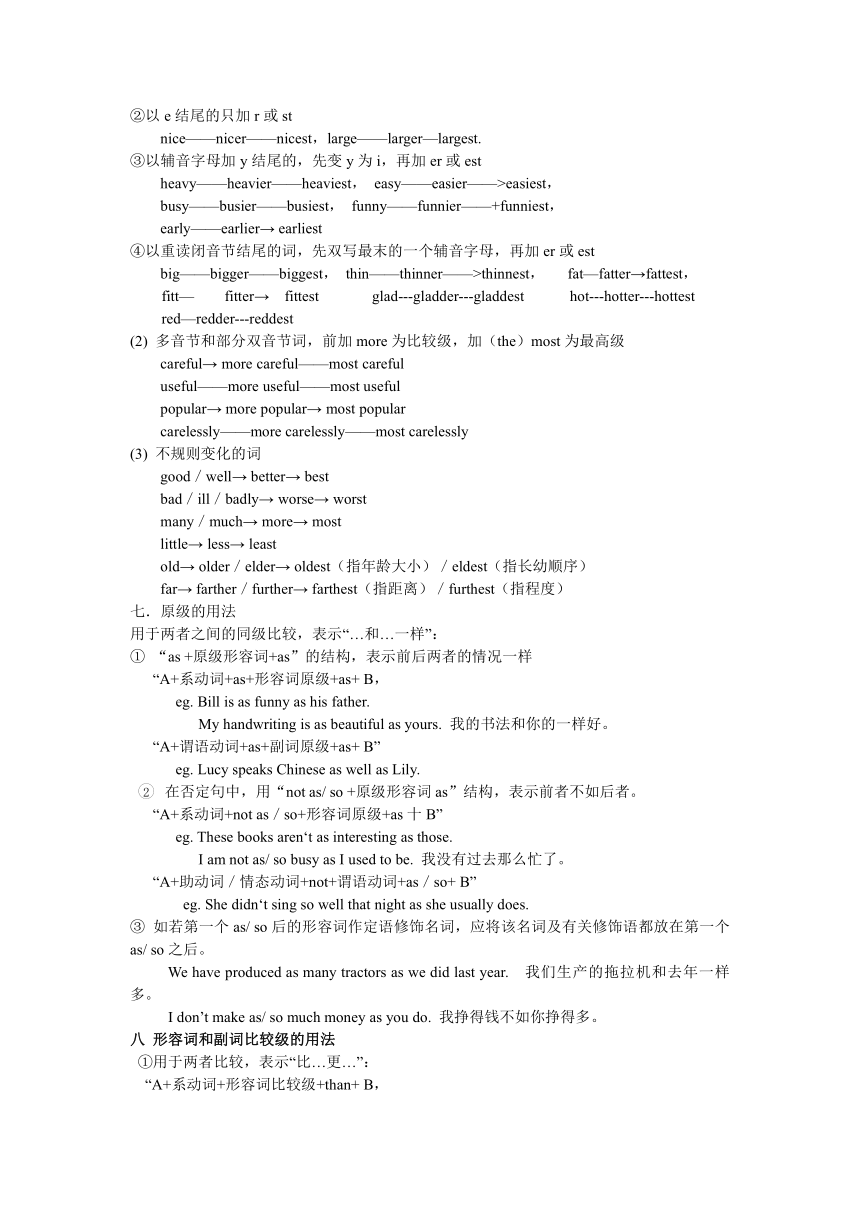中考英语专题复习-形容词知识点总结
图片预览




文档简介
形容词
一.定义:形容词(adj.)
主要是用来描述和修饰名词、代词,说明其性质、状态和特征。形容词主要用来描述事物的大小、形状、颜色等具体特征,也可用来陈述事物的状态等。
二.形容词的特征
1.作定语,常置于被修饰词的前面
He
is
a
good
actor.
他是一名好演员。
2.作表语,置于连系动词后面
The
baby
is
still
asleep.
Will
you
please
make
less
noise?
宝宝还在睡觉,你小声点好吗?
3.多数形容词具有比较等级
One
of
the
most
important
languages
is
English.
英语是最重要的语言之一。
4.具有独特的后缀姓氏
-able,
-ible
Comfortable
合适的
Terrible
糟糕的
Horrible
可怕的
-al,
-ical
National
国家的
Political
政治的
Natural
自然的Chemical
化学的
Typical
典型的
magical
魔术的
--ant
Important
重要的
Pleasant
令人愉快的
Assistant
辅助的
--ary
Ordinary
普通的
Necessary
必要的
Secondary
次要的
-ful
Beautiful
漂亮的
Wonderful
精彩的
Careful
细心的
--less
Hopeless
没有希望的
Careless
粗心的
Helpless
无助的
--ly
Lovely
可爱的
Friendly
友善的
Weekly
每周的
-ous,
--ious
Famous
著名的
Dangerous
危险的
Serious
严肃的
--some
Handsome
潇洒的
Tiresome
烦人的
Troublesome
引起麻烦的
--y
Angry
生气的
Snowy
多雪的
Sunny
晴朗的
三.形容词的分类
1.根据其构成分类
A
简单形容词
Kind
善良的
green
绿色的
interesting
有趣的
B
合成形容词
合成形容词是指由几个词共同组成并起到形容词作用的词。主要用作定语,一般不作表语。
1
数词+
名词+形容词
A
ten-metre-wide
river
一条十米宽的河
a
five-year-old
girl
一个五岁的女孩
②
形容词(或数词)+名词+-ed
A
middle-aged
man
一位中年男子
a
fifteen-storeyed
building
一座十五层的大楼
③形容词+V-ing
形式
A
good-looking
man
一位相貌英俊的男子
an
easy-going
woman
一位随和的女子
④
名词+V-ed
形式
A
man-made
lake
人工湖
a
snow-covered
mountain一座被雪覆盖的山
⑤
副词/形容词+
V-ed形式
A
well-known
writer一位著名的作家
a
new-born
baby一个新生儿
2.根据与名词的关系分类
A
限制性形容词:指描述事物本质的形容词,它与名词紧紧相连,这些形容词如果去掉会严重影响原来的本意。
An
English
dish英式菜
a
French
table法国制造的桌子
B
描述性形容词:又称非限制性形容词,置于名词之前,常对名词进行描述,省略之后也不会影响所修饰名词的本意。
A
delicious
English
dish
一道美味的英式菜
a
smooth
French
table一张光滑的法国制造的桌子
3.
根据形容词本身的性质分类
A
等级形容词:指直接说明人或事物的特征、性质并有比较等级变化的形容词,可以用程度副词来修饰。在句中可作定语、表语和补足语。
Mary
has
a
nice
voice.
玛丽有一副好嗓子。
Cities
today
seem
to
be
becoming
much
busier
than
ever
before.
今天的城市似乎变得更加繁忙了。
We’re
making
every
effort
to
make
our
environment
much
cleaner
and
safer.
我们在努力使环境变得更加干净、更安全。
B
表语形容词:有一类形容词在句中常作表语,不作前置定语,这种形容词称为表语形容词。以元音字母开头的形容词大多属于这一类。
Little
Linda
is
not
afraid
of
dog.
小琳达不害怕狗。
Mum
has
been
ill
for
nearly
a
week.
妈妈病了近一周了。
Go
and
see
if
the
baby
is
awake
or
asleep.
去看看孩子是醒着还是睡着了。
常用必备:常见的可作表语的形容词
Afraid
害怕的
alive
活着的
alone单独的
asleep
睡着的
awake醒着的
ready准备好的
sorry
抱歉的
well身体健康的
worth值得的
ashamed
羞愧的
alike
相似的
四.形容词的句法功能
形容词在句中可作定语、表语、宾语补足语、主语补足语或状语等。
This
is
a
difficult
problem
to
solve.
这是一个很难解决的问题。(作定语)
Maggie
is
very
polite.
玛吉很有礼貌。
(作表语)
Don’t
make
your
parents
angry.
不要让你父母生气。(作宾语补足语)
The
room
was
found
very
dirty.
发现房间很脏。(作主语补足语)
He
arrived
home,
hungry
and
tired.
他又累又饿地回到家里。(作状语)
五.形容词的位置
形容词在句中的位置主要指作定语时与名词的排列顺序。
1置于名词前
I
often
have
a
joyful
heart.
我通常都是心情愉快。
2.置于名词或代词后
A
一些表语形容词,如:alive,
afraid,
alone,
asleep,
worth等作定语,常置于被修饰词的后面。
The
baby
still
asleep
might
be
awake
very
soon.
还在熟睡的宝宝可能马上就会醒来。
特别提示:作前置定语和后置定语时意义不同的形容词
What
is
your
present
address?
你现在的地址是什么?
The
people
present
at
the
meeting
are
mostly
from
the
west
of
China.
出席会议的人大多数来自中国的西部。
B
形容词在修饰someone,
something,
anyone,
anything,
nothing等复合不定代词时,需要置于其后。
Attention,
please!
I’ve
got
something
important
to
tell
you
all.
大家请注意!我有重要的事情要告诉你们。
There
you
go.
It’s
nothing
serious
at
all.
得了吧,根本没什么严重的事情。
C
当定语是“形容词+介词+名词”时,要放在名词的后面
He
gave
me
a
box
full
of
books.
他给了我一个盛满书的箱子。
D
两个意义相反的形容词中间用and或or连接作定语时,常放在名词的后面。
All
the
people
on
this
island,
young
or
old,
are
all
fond
of
music.
这个岛上的人,不论年轻的还是年老的都喜欢音乐。
E
away,
long,
wide,
high,
deep,
old等词附有数词短语说明时,要后置。
The
river
is
20
meters
wide.
这条河二十米宽。
3.
多个形容词修饰名词时的排列顺序
多个形容词同时修饰一个名词时,这些形容词的位置由它们和被修饰名词的关系的密切程度来决定。一般关系最密切的靠被修饰词最近,但也有规律可循,一般的排列顺序如下:
限定词(冠词,指示代词,物主代词,数词等)
描绘形容词
形状
大小、长短、年龄、新旧
颜色
产地、来源
材料、种类
用途
(被修饰的)名词
My
first
few
sunny
days
The
other
two
beautiful
round
Smallold
white
French
wooden
writing
desks
his
grey
stone
bench
that
square
new
box
六.形容词的比较等级
英语中的形容词通常用三种形式来表达事物的等级差别,分别是原级、比较级和最高级。大部分形容词的比较级和最高级是通过变化词尾来实现的,属于规则变化,但也有少数是不规则变化。
英语中有些形容词说明形状、材质等,还有些形容词没有程度可分或其本身就表示某种程度,故而没有比较级和最高级。常见的有:
Right正确的
wrong错误的
possible可能的
east东方的
empty空的
Impossible不可能的
favorite最喜欢的
round圆的
golden金色的
1.比较级、最高级的构成
(1)单音节和少数双音节词
①一般在词尾加er或est
great——greater——greatest,young——younger——youngest,slow→slower→slowest
②以e结尾的只加r或st
nice——nicer——nicest,large——larger—largest.
③以辅音字母加y结尾的,先变y为i,再加er或est
heavy——heavier——heaviest,
easy——easier——>easiest,
busy——busier——busiest,
funny——funnier——+funniest,
early——earlier→
earliest
④以重读闭音节结尾的词,先双写最末的一个辅音字母,再加er或est
big——bigger——biggest,
thin——thinner——>thinnest,
fat—fatter→fattest,
fitt—
fitter→
fittest
glad---gladder---gladdest
hot---hotter---hottest
red—redder---reddest
(2)
多音节和部分双音节词,前加more为比较级,加(the)most为最高级
careful→
more
careful——most
careful
useful——more
useful——most
useful
popular→
more
popular→
most
popular
carelessly——more
carelessly——most
carelessly
(3)
不规则变化的词
good/well→
better→
best
bad/ill/badly→
worse→
worst
many/much→
more→
most
little→
less→
least
old→
older/elder→
oldest(指年龄大小)/eldest(指长幼顺序)
far→
farther/further→
farthest(指距离)/furthest(指程度)
七.原级的用法
用于两者之间的同级比较,表示“…和…一样”:
①
“as
+原级形容词+as”的结构,表示前后两者的情况一样
“A+系动词+as+形容词原级+as+
B,
eg.
Bill
is
as
funny
as
his
father.
My
handwriting
is
as
beautiful
as
yours.
我的书法和你的一样好。
“A+谓语动词+as+副词原级+as+
B”
eg.
Lucy
speaks
Chinese
as
well
as
Lily.
2
在否定句中,用“not
as/
so
+原级形容词as”结构,表示前者不如后者。
“A+系动词+not
as/so+形容词原级+as十B”
eg.
These
books
aren‘t
as
interesting
as
those.
I
am
not
as/
so
busy
as
I
used
to
be.
我没有过去那么忙了。
“A+助动词/情态动词+not+谓语动词+as/so+
B”
eg.
She
didn‘t
sing
so
well
that
night
as
she
usually
does.
③
如若第一个as/
so后的形容词作定语修饰名词,应将该名词及有关修饰语都放在第一个as/
so之后。
We
have
produced
as
many
tractors
as
we
did
last
year.
我们生产的拖拉机和去年一样多。
I
don’t
make
as/
so
much
money
as
you
do.
我挣得钱不如你挣得多。
八
形容词和副词比较级的用法
①用于两者比较,表示“比…更…”:
“A+系动词+形容词比较级+than+
B,
eg.
I
am
two
years
older
than
my
little
sister.
“A+谓语动词+副词比较级+than+
B:
eg.
She
gets
to
school
earlier
than
the
other
students.
2
“比较级+and+比较级”,这种结构表示事物本身程度的逐渐增长,意为“越来越…”。
eg.
In
spring
the
days
are
getting
longer
and
longer.
在春天,白天变得越来越长。
③
“the+比较级…the+比较级”,这种结构用来表示一方的程度随着另一方的程度的增长而增长,
表示“越…,越…”。
eg.
The
mort
you
practice
using
English,the
better
you‘ll
learn
it
你英语练得越多,就会学得越好。
④“A十动词十the+比较级+of短语(比较范围)”,这种结构表示“两者中更……的那一个”。当比较双方只出现一方(没有than及其后面的部分),且句中含有of
the
two……时,比较级前要加the.
eg.
Penny
is
the
taller
of
the
two
girls.
Penny是这两个女孩中较高的一个。
The
larger
of
the
two
houses
belongs
to
Mr
Black.
两座房子中较大的那座属于布莱克先生。
⑤表示两者程度不同的其他方式
可用more
than(多于……),
not
more
than(不多于……),
less
than(少于……),
not
less
than(不少于……),
less+形容词+
than(不如……)等。
We
haven’t
got
more
than
one
hour
left
right
now.
我们就还有不到一个小时了。
It
is
less
cold
today
than
it
was
yesterday.
今天没有昨天冷。
⑥
“not+比较级
+than”与“no+比较级+than”
这两个结构表达的意思完全不同,通常,前者往往表示“一方不比另一方……”,后者往往表示“前者和后者一样都不…”;修饰说明数量时,前者表示“最多,不比……多”,后者表示“仅仅”,带有感彩。
I
am
not
taller
than
you.
我不比你高。
I
am
no
taller
than
you.
我和你一样高。
My
French
is
not
better
than
yours.
我的法语不比你的好。
My
French
is
no
better
than
yours.
我的法语和你的一样差。
She
is
not
more
than
seven
years
old.
她不到七岁。
She
is
no
more
than
seven
years
old.
她仅有七岁。
修饰比较级时常见的错误
A
more不可修饰比较级,但much可以用来加强比较级,意为“……的多,更……”
He
looks
more
younger
than
I.
(×)
He
looks
much
younger
than
I.
(√
)
B
比较的对象或范围出现错误。
1)The
weather
of
Beijing
is
colder
than
Shanghai.
(×)
北京的天气比上海冷。(比较的对象应该是上海的天气,而不是上海)
The
weather
of
Beijing
is
colder
than
that
of
Shanghai.
(√)
2)China
is
larger
than
any
country
in
Asia.
(×)
(出现了逻辑上的错误。
中国就是亚洲的一个国家,应当排除在外。)
China
is
larger
than
any
country
in
Africa.
(√)
中国比非洲的任何国家都大。
China
is
larger
than
any
other
country
in
Asia.
(√)
中国比亚洲的任何(其他的)国家都大。
特别提示
Than后代词的主、宾格
Than后面接代词时,一般要用主格,但在口语中也可使用宾格。如果than后是一个句子,则不可使用宾格。
He
works
harder
than
me.
他比我用功。
He
works
harder
than
I
do.
他比我用功。
九.最高级的用法
最高级是表示在三者或更多者中程度最高的比较方式
1
the+
形容词最高级+名词+表示范围的短语或从句
Jack
is
the
tallest
student
in
his
class.
杰克是他班上最高的学生。
He
is
the
fastest
runner
of
the
three
boys.
他是这三个男孩中跑得最快的。
This
is
the
most
boring
book
I’ve
ever
read.
这是我读过的最乏味的书。
②
one
of
the+形容词最高级+名词复数+表示范围的短语或从句
China
is
one
of
the
largest
countries
in
the
world.
中国是世界上最大的国家之一。
用法比较:介词in和of引导的短语说明比较的范围
如果在一定的地域空间内进行比较用in;
如果在同一类事物范围内进行比较用of.
China
is
the
largest
country
in
Asia.
中国是亚洲最大的国家。
China
is
the
largest
one
of
all
the
Asian
countries.
中国是亚洲所有国家中最大的。
3
运用比较级表达最高级的概念
“比较级+than
any
other+名词复数”,“比较级+than
the
other+名词复数”或“比较级+than
the
rest
of
+the+名词复数”都可表示最高级意义。
Julia
is
taller
than
any
other
girl
in
her
class.
Julia
is
taller
than
the
other
girls
in
her
class.
Julia
is
taller
than
the
rest
of
the
girls
in
her
class.
以上三句表达的意思等同于最高级的含义:
Julia
is
the
tallest
of
the
girls
in
her
class.
朱丽叶是她们班上最高的女生。
十.比较级和最高级的修饰语
1.
比较级的修饰语
Much(……得多),far(……得多),even(甚至,更),still(更),a
bit(有点),a
little(有点),a
lot(很),
a
great
deal(大大地),
twice(两倍),
five
times(五倍),
two-fifths(五分之二),
a
half(一半)等修饰比较级表示程度,但决不可用very修饰。
eg.
Tom
is
a
little
taller
than
Mike.
Tom比Mike稍高一点;
It
is
even
colder
today
than
yesterday.
今天甚至比昨天更冷
2.最高级的修饰语
By
far/
far
and
away
最,很
much
……得多
almost
几乎
nearly
几乎
The
Yellow
River
is
the
second
longest
river
in
China.
黄河是中国第二长河。
This
is
(by)
far
the
best
book
that
I’ve
ever
read.
这是我读过的最好的书。
十一.
比较结构的同义转换
有时,不同的比较结构可以表示相同的意思,因此,它们可以相互转换。
1.
not
as/
so……as与less……than的转换
The
place
was
not
as/
so
crowded
as
it
usually
is
yesterday.
The
place
was
less
crowded
than
it
usually
is
yesterday.
昨天,这个地方不像平常那样挤满了人。
2.
more……than与less……than,
not
as/
so…as的转换
Your
picture
is
more
beautiful
than
his.
His
picture
is
less
beautiful
than
yours.
His
picture
isn’t
as/
so
beautiful
as
yours.
你的画比他的好看。
3.最高级与more……than,
no……more
than的转换
Math
is
the
most
difficult
subject
of
all.
Math
is
more
difficult
than
any
other
subject.
No
subject
is
more
difficult
than
math.
数学是所有学科中最难的。
十二.
形容词的常用句型
1.
It’s
+形容词+
of+
sb.
+动词不定式
这一句型表示“某人(做某事)……”。常用形容词有:good,
kind,
nice,
polite,
clever,
foolish,
lazy,
careful,
careless,
right,
wrong等,来说明“人”的性质或特征。
It’s
very
kind
of
you
to
help
me.
你能帮助我真是太好了。
It’s
foolish
of
you
to
make
such
mistake.
你真傻啊,竟然犯这种错误。
2.
It’s
+形容词+for
+
sb.
+动词不定式
这一句型表示“做某事对某人来说……”。常用形容词有:difficult,
easy,
hard,
dangerous,
safe,
useful,
pleasant,
interesting,
impossible等,来说明动词不定式的性质、特征。
It
is
impossible
for
a
child
to
answer
the
question.
小孩子不可能回答出这个问题。
It’s
dangerous
for
you
to
swim
alone.
你自己一个人去游泳很危险。
3.
主语+be动词
+形容词+动词不定式
这一句型常用表示感情或情绪的形容词,如:glad,
pleased,
sorry,
sad,
thankful等以及表示能力和意志的形容词,如:ready,
able,
sure,
certain等。
I’m
very
sorry
to
hear
the
news.
听到这个消息我很难过。
I’m
glad
to
see
you.
见到你我很高兴。
Comrade
Lei
Feng
is
always
ready
to
help
others.
雷锋同志总是乐于帮助别人。
Tom
is
sure/
certain
to
come.
汤姆一定会来。
十二.
形容词与介词的搭配
在英语中,有很多形容词后需要加特定的介词,构成固定的搭配。
1.
与about构成的搭配
Be
anxious
about
对……感到担心
be
sorry
about
对……感到抱歉
Be
careful
about
对……小心
be
sure
about对……有把握
Be
certain
about
对……有把握
be
worried
about
对……担忧
2.
与构成的搭配
Be
expert
at
具……方面的专长
be
surprised
at
对……感到惊讶
Be
angry
at
对……生气
be
good
at
在……方面擅长
Be
clever
at
在……方面生气
3.
与for构成的搭配
Be
famous
for
由于……而著名
be
well
known
for由于……而著名
Be
ready
for
为……做好准备
get
ready
for
为……做好准备
Be
sorry
for
为……感到抱歉
be
fit/
unfit
for
适合……/
不适合……
Be
good
for
对……有帮助
be
bad
for对……有坏处
4.与in构成的搭配
Be
interested
in
对……感兴趣
be
weak
in
在……方面薄弱
Be
poor
in
在……方面薄弱
be
different
in
在……方面不同
Be
experienced
in
具有……方面的经验
5.与of构成的搭配
Be
afraid
of
害怕……
be
certain
of
对……有把握
Be
fond
of
喜欢……
be
proud
of
为……感到自豪
Be
tired
of
对……感到厌倦
be
full
of
充满……
Be
sure
of
对……有把握
be
short
of
……短缺
Be
ashamed
of
对……感到羞愧
6.与to构成的搭配
Be
good
to
对……态度好
be
kind
to
对……和蔼
Be
nice
to
对……友好
be
rude
to
对……粗鲁
Be
polite
to
对……有礼貌
be
bad
to
对……态度不好
Be
useful
to
对……有用
7.
与with构成的搭配
Be
angry
with
对……生气
be
careful
with小心……
Be
busy
with忙于……
be
satisfied
with对……感到满意
Be
pleased
with
对……感到满意
be
happy
with
对……感到高兴
Be
patient
with
对……有耐心
be
strict
with
对某人要求严格
特别提示
形容词后跟不同介词时的意义
1.
有些形容词后跟不同的介词意义差别不大
Be
experienced
at/
in具有……方面的经验
be
sure
of/
about对……有把握
Be
certain
of/
about
对……有把握
2.有些形容词后跟不同的介词意义不同
Be
good
at
在……方面擅长
be
good
to对……友好
Be
good
for
对……有帮助
十三.
常见形容词用法比较
1.elder
和older
二者均为形容词old的比较级形式
1
elder为“年长的”,只指人,用来比较年龄长幼,尤指兄弟姐妹的长幼关系,它只能用在名词前作定语,不能用于than引导的比较状语从句中。
Jordan
is
the
fourth
of
five
children,
having
two
elder
brothers
and
an
elder
and
a
younger
sister.
乔丹在五个孩子中排行第四,有两个哥哥,一个姐姐和一个妹妹。
2
older为“年龄较大的,较老的,较旧的”,可指人,也可指物,作定语或表语,能用在than引导的比较状语从句中。
My
elder
brother
is
7
years
older
than
my
younger
sister.
我哥比我妹大七岁。
2.
good
和well
good和well都表示“好”。通常,作定语或表语时用good,作状语时用well;表示“身体好的”用well.
Doing
sports
is
good
for
us.
做运动对我们有益。(作表语)
Sandy
dances
well
and
she
is
a
good
dancer.
桑迪舞跳得好,她是个出色的舞者。(well作状语,good作定语)
---How
are
you?
你好吗?
---I
am
very
well.
我很好。(作表语,表示“身体好的”)
3.
huge,
big,
large,和great
它们都有“大的”意思,但用法不同
①
huge强调尺寸、体积“庞大”(指体积时,比large,
great所指的体积大),容量和数量“巨大”,不强调重量。
About
ten
years
ago
scientists
from
the
United
States
and
Mexico
found
that
the
large
object
caused
a
huge
hole
in
Mexico.
大约在十年前,来自美国和墨西哥的科学家在墨西哥发现这个巨大的物体导致一个大坑。
②big最通俗、常用,强调比正常程度、范围及规模的标准大,常用于修饰人、物或数量。反义词是little或small
My
best
friend
is
Xiao
Li,
but
last
week
in
school
we
had
a
big
fight.
我最好的朋友是小李,但上星期我们在学校大吵了一架。
③
large强调远远超过标准的“大”,可指数量、容量、体积和面积,比big正式,反义词是small.
So
it
is
proved
that
the
large
object
had
a
close
relation
with
the
death
of
dinosaurs
and
other
animals.
所以证明,这个巨大的物体与恐龙和其他动物的灭绝有关系。
3
great通常指抽象的事物。可表数量、距离和程度,修饰人时,意为“伟大的”。
This
is
a
great
chance
that
many
people
do
not
have.
这是一个很多人没有的好机会。
4.
interest,
interested和interesting
①Interest用作名词,意为“兴趣”,其主语为人或物。
There
are
also
weekend
visits
organized
to
San
Francisco
and
other
places
of
interest
in
California.
还有周末组织的到圣弗兰西斯科和加利福尼亚的其他名胜的旅游参观。
This
subject
has
no
interest
for
me.
对我来说,这科没趣。
2
interested用作形容词,意为“感兴趣的”,常构成系表结构“be
interested”,其主语只能是人,其后可接动词不定式,”in+
doing”或”in+名词”表示“某人对……感兴趣”
But
now
I’m
more
interested
in
sports.
但是现在,我对运动更感兴趣了。
3
interesting用作形容词,意为“令人感兴趣的”。在句中可以作定语,也可以作表语。常构成系表结构,主语可以是人,也可以是物。
----I’m
going
to
Tibet
for
a
week.
我打算到西藏一个星期。
----That
sounds
interesting.
听起来很有趣。
This
is
an
interesting
film.
这是部有趣的电影。
一.定义:形容词(adj.)
主要是用来描述和修饰名词、代词,说明其性质、状态和特征。形容词主要用来描述事物的大小、形状、颜色等具体特征,也可用来陈述事物的状态等。
二.形容词的特征
1.作定语,常置于被修饰词的前面
He
is
a
good
actor.
他是一名好演员。
2.作表语,置于连系动词后面
The
baby
is
still
asleep.
Will
you
please
make
less
noise?
宝宝还在睡觉,你小声点好吗?
3.多数形容词具有比较等级
One
of
the
most
important
languages
is
English.
英语是最重要的语言之一。
4.具有独特的后缀姓氏
-able,
-ible
Comfortable
合适的
Terrible
糟糕的
Horrible
可怕的
-al,
-ical
National
国家的
Political
政治的
Natural
自然的Chemical
化学的
Typical
典型的
magical
魔术的
--ant
Important
重要的
Pleasant
令人愉快的
Assistant
辅助的
--ary
Ordinary
普通的
Necessary
必要的
Secondary
次要的
-ful
Beautiful
漂亮的
Wonderful
精彩的
Careful
细心的
--less
Hopeless
没有希望的
Careless
粗心的
Helpless
无助的
--ly
Lovely
可爱的
Friendly
友善的
Weekly
每周的
-ous,
--ious
Famous
著名的
Dangerous
危险的
Serious
严肃的
--some
Handsome
潇洒的
Tiresome
烦人的
Troublesome
引起麻烦的
--y
Angry
生气的
Snowy
多雪的
Sunny
晴朗的
三.形容词的分类
1.根据其构成分类
A
简单形容词
Kind
善良的
green
绿色的
interesting
有趣的
B
合成形容词
合成形容词是指由几个词共同组成并起到形容词作用的词。主要用作定语,一般不作表语。
1
数词+
名词+形容词
A
ten-metre-wide
river
一条十米宽的河
a
five-year-old
girl
一个五岁的女孩
②
形容词(或数词)+名词+-ed
A
middle-aged
man
一位中年男子
a
fifteen-storeyed
building
一座十五层的大楼
③形容词+V-ing
形式
A
good-looking
man
一位相貌英俊的男子
an
easy-going
woman
一位随和的女子
④
名词+V-ed
形式
A
man-made
lake
人工湖
a
snow-covered
mountain一座被雪覆盖的山
⑤
副词/形容词+
V-ed形式
A
well-known
writer一位著名的作家
a
new-born
baby一个新生儿
2.根据与名词的关系分类
A
限制性形容词:指描述事物本质的形容词,它与名词紧紧相连,这些形容词如果去掉会严重影响原来的本意。
An
English
dish英式菜
a
French
table法国制造的桌子
B
描述性形容词:又称非限制性形容词,置于名词之前,常对名词进行描述,省略之后也不会影响所修饰名词的本意。
A
delicious
English
dish
一道美味的英式菜
a
smooth
French
table一张光滑的法国制造的桌子
3.
根据形容词本身的性质分类
A
等级形容词:指直接说明人或事物的特征、性质并有比较等级变化的形容词,可以用程度副词来修饰。在句中可作定语、表语和补足语。
Mary
has
a
nice
voice.
玛丽有一副好嗓子。
Cities
today
seem
to
be
becoming
much
busier
than
ever
before.
今天的城市似乎变得更加繁忙了。
We’re
making
every
effort
to
make
our
environment
much
cleaner
and
safer.
我们在努力使环境变得更加干净、更安全。
B
表语形容词:有一类形容词在句中常作表语,不作前置定语,这种形容词称为表语形容词。以元音字母开头的形容词大多属于这一类。
Little
Linda
is
not
afraid
of
dog.
小琳达不害怕狗。
Mum
has
been
ill
for
nearly
a
week.
妈妈病了近一周了。
Go
and
see
if
the
baby
is
awake
or
asleep.
去看看孩子是醒着还是睡着了。
常用必备:常见的可作表语的形容词
Afraid
害怕的
alive
活着的
alone单独的
asleep
睡着的
awake醒着的
ready准备好的
sorry
抱歉的
well身体健康的
worth值得的
ashamed
羞愧的
alike
相似的
四.形容词的句法功能
形容词在句中可作定语、表语、宾语补足语、主语补足语或状语等。
This
is
a
difficult
problem
to
solve.
这是一个很难解决的问题。(作定语)
Maggie
is
very
polite.
玛吉很有礼貌。
(作表语)
Don’t
make
your
parents
angry.
不要让你父母生气。(作宾语补足语)
The
room
was
found
very
dirty.
发现房间很脏。(作主语补足语)
He
arrived
home,
hungry
and
tired.
他又累又饿地回到家里。(作状语)
五.形容词的位置
形容词在句中的位置主要指作定语时与名词的排列顺序。
1置于名词前
I
often
have
a
joyful
heart.
我通常都是心情愉快。
2.置于名词或代词后
A
一些表语形容词,如:alive,
afraid,
alone,
asleep,
worth等作定语,常置于被修饰词的后面。
The
baby
still
asleep
might
be
awake
very
soon.
还在熟睡的宝宝可能马上就会醒来。
特别提示:作前置定语和后置定语时意义不同的形容词
What
is
your
present
address?
你现在的地址是什么?
The
people
present
at
the
meeting
are
mostly
from
the
west
of
China.
出席会议的人大多数来自中国的西部。
B
形容词在修饰someone,
something,
anyone,
anything,
nothing等复合不定代词时,需要置于其后。
Attention,
please!
I’ve
got
something
important
to
tell
you
all.
大家请注意!我有重要的事情要告诉你们。
There
you
go.
It’s
nothing
serious
at
all.
得了吧,根本没什么严重的事情。
C
当定语是“形容词+介词+名词”时,要放在名词的后面
He
gave
me
a
box
full
of
books.
他给了我一个盛满书的箱子。
D
两个意义相反的形容词中间用and或or连接作定语时,常放在名词的后面。
All
the
people
on
this
island,
young
or
old,
are
all
fond
of
music.
这个岛上的人,不论年轻的还是年老的都喜欢音乐。
E
away,
long,
wide,
high,
deep,
old等词附有数词短语说明时,要后置。
The
river
is
20
meters
wide.
这条河二十米宽。
3.
多个形容词修饰名词时的排列顺序
多个形容词同时修饰一个名词时,这些形容词的位置由它们和被修饰名词的关系的密切程度来决定。一般关系最密切的靠被修饰词最近,但也有规律可循,一般的排列顺序如下:
限定词(冠词,指示代词,物主代词,数词等)
描绘形容词
形状
大小、长短、年龄、新旧
颜色
产地、来源
材料、种类
用途
(被修饰的)名词
My
first
few
sunny
days
The
other
two
beautiful
round
Smallold
white
French
wooden
writing
desks
his
grey
stone
bench
that
square
new
box
六.形容词的比较等级
英语中的形容词通常用三种形式来表达事物的等级差别,分别是原级、比较级和最高级。大部分形容词的比较级和最高级是通过变化词尾来实现的,属于规则变化,但也有少数是不规则变化。
英语中有些形容词说明形状、材质等,还有些形容词没有程度可分或其本身就表示某种程度,故而没有比较级和最高级。常见的有:
Right正确的
wrong错误的
possible可能的
east东方的
empty空的
Impossible不可能的
favorite最喜欢的
round圆的
golden金色的
1.比较级、最高级的构成
(1)单音节和少数双音节词
①一般在词尾加er或est
great——greater——greatest,young——younger——youngest,slow→slower→slowest
②以e结尾的只加r或st
nice——nicer——nicest,large——larger—largest.
③以辅音字母加y结尾的,先变y为i,再加er或est
heavy——heavier——heaviest,
easy——easier——>easiest,
busy——busier——busiest,
funny——funnier——+funniest,
early——earlier→
earliest
④以重读闭音节结尾的词,先双写最末的一个辅音字母,再加er或est
big——bigger——biggest,
thin——thinner——>thinnest,
fat—fatter→fattest,
fitt—
fitter→
fittest
glad---gladder---gladdest
hot---hotter---hottest
red—redder---reddest
(2)
多音节和部分双音节词,前加more为比较级,加(the)most为最高级
careful→
more
careful——most
careful
useful——more
useful——most
useful
popular→
more
popular→
most
popular
carelessly——more
carelessly——most
carelessly
(3)
不规则变化的词
good/well→
better→
best
bad/ill/badly→
worse→
worst
many/much→
more→
most
little→
less→
least
old→
older/elder→
oldest(指年龄大小)/eldest(指长幼顺序)
far→
farther/further→
farthest(指距离)/furthest(指程度)
七.原级的用法
用于两者之间的同级比较,表示“…和…一样”:
①
“as
+原级形容词+as”的结构,表示前后两者的情况一样
“A+系动词+as+形容词原级+as+
B,
eg.
Bill
is
as
funny
as
his
father.
My
handwriting
is
as
beautiful
as
yours.
我的书法和你的一样好。
“A+谓语动词+as+副词原级+as+
B”
eg.
Lucy
speaks
Chinese
as
well
as
Lily.
2
在否定句中,用“not
as/
so
+原级形容词as”结构,表示前者不如后者。
“A+系动词+not
as/so+形容词原级+as十B”
eg.
These
books
aren‘t
as
interesting
as
those.
I
am
not
as/
so
busy
as
I
used
to
be.
我没有过去那么忙了。
“A+助动词/情态动词+not+谓语动词+as/so+
B”
eg.
She
didn‘t
sing
so
well
that
night
as
she
usually
does.
③
如若第一个as/
so后的形容词作定语修饰名词,应将该名词及有关修饰语都放在第一个as/
so之后。
We
have
produced
as
many
tractors
as
we
did
last
year.
我们生产的拖拉机和去年一样多。
I
don’t
make
as/
so
much
money
as
you
do.
我挣得钱不如你挣得多。
八
形容词和副词比较级的用法
①用于两者比较,表示“比…更…”:
“A+系动词+形容词比较级+than+
B,
eg.
I
am
two
years
older
than
my
little
sister.
“A+谓语动词+副词比较级+than+
B:
eg.
She
gets
to
school
earlier
than
the
other
students.
2
“比较级+and+比较级”,这种结构表示事物本身程度的逐渐增长,意为“越来越…”。
eg.
In
spring
the
days
are
getting
longer
and
longer.
在春天,白天变得越来越长。
③
“the+比较级…the+比较级”,这种结构用来表示一方的程度随着另一方的程度的增长而增长,
表示“越…,越…”。
eg.
The
mort
you
practice
using
English,the
better
you‘ll
learn
it
你英语练得越多,就会学得越好。
④“A十动词十the+比较级+of短语(比较范围)”,这种结构表示“两者中更……的那一个”。当比较双方只出现一方(没有than及其后面的部分),且句中含有of
the
two……时,比较级前要加the.
eg.
Penny
is
the
taller
of
the
two
girls.
Penny是这两个女孩中较高的一个。
The
larger
of
the
two
houses
belongs
to
Mr
Black.
两座房子中较大的那座属于布莱克先生。
⑤表示两者程度不同的其他方式
可用more
than(多于……),
not
more
than(不多于……),
less
than(少于……),
not
less
than(不少于……),
less+形容词+
than(不如……)等。
We
haven’t
got
more
than
one
hour
left
right
now.
我们就还有不到一个小时了。
It
is
less
cold
today
than
it
was
yesterday.
今天没有昨天冷。
⑥
“not+比较级
+than”与“no+比较级+than”
这两个结构表达的意思完全不同,通常,前者往往表示“一方不比另一方……”,后者往往表示“前者和后者一样都不…”;修饰说明数量时,前者表示“最多,不比……多”,后者表示“仅仅”,带有感彩。
I
am
not
taller
than
you.
我不比你高。
I
am
no
taller
than
you.
我和你一样高。
My
French
is
not
better
than
yours.
我的法语不比你的好。
My
French
is
no
better
than
yours.
我的法语和你的一样差。
She
is
not
more
than
seven
years
old.
她不到七岁。
She
is
no
more
than
seven
years
old.
她仅有七岁。
修饰比较级时常见的错误
A
more不可修饰比较级,但much可以用来加强比较级,意为“……的多,更……”
He
looks
more
younger
than
I.
(×)
He
looks
much
younger
than
I.
(√
)
B
比较的对象或范围出现错误。
1)The
weather
of
Beijing
is
colder
than
Shanghai.
(×)
北京的天气比上海冷。(比较的对象应该是上海的天气,而不是上海)
The
weather
of
Beijing
is
colder
than
that
of
Shanghai.
(√)
2)China
is
larger
than
any
country
in
Asia.
(×)
(出现了逻辑上的错误。
中国就是亚洲的一个国家,应当排除在外。)
China
is
larger
than
any
country
in
Africa.
(√)
中国比非洲的任何国家都大。
China
is
larger
than
any
other
country
in
Asia.
(√)
中国比亚洲的任何(其他的)国家都大。
特别提示
Than后代词的主、宾格
Than后面接代词时,一般要用主格,但在口语中也可使用宾格。如果than后是一个句子,则不可使用宾格。
He
works
harder
than
me.
他比我用功。
He
works
harder
than
I
do.
他比我用功。
九.最高级的用法
最高级是表示在三者或更多者中程度最高的比较方式
1
the+
形容词最高级+名词+表示范围的短语或从句
Jack
is
the
tallest
student
in
his
class.
杰克是他班上最高的学生。
He
is
the
fastest
runner
of
the
three
boys.
他是这三个男孩中跑得最快的。
This
is
the
most
boring
book
I’ve
ever
read.
这是我读过的最乏味的书。
②
one
of
the+形容词最高级+名词复数+表示范围的短语或从句
China
is
one
of
the
largest
countries
in
the
world.
中国是世界上最大的国家之一。
用法比较:介词in和of引导的短语说明比较的范围
如果在一定的地域空间内进行比较用in;
如果在同一类事物范围内进行比较用of.
China
is
the
largest
country
in
Asia.
中国是亚洲最大的国家。
China
is
the
largest
one
of
all
the
Asian
countries.
中国是亚洲所有国家中最大的。
3
运用比较级表达最高级的概念
“比较级+than
any
other+名词复数”,“比较级+than
the
other+名词复数”或“比较级+than
the
rest
of
+the+名词复数”都可表示最高级意义。
Julia
is
taller
than
any
other
girl
in
her
class.
Julia
is
taller
than
the
other
girls
in
her
class.
Julia
is
taller
than
the
rest
of
the
girls
in
her
class.
以上三句表达的意思等同于最高级的含义:
Julia
is
the
tallest
of
the
girls
in
her
class.
朱丽叶是她们班上最高的女生。
十.比较级和最高级的修饰语
1.
比较级的修饰语
Much(……得多),far(……得多),even(甚至,更),still(更),a
bit(有点),a
little(有点),a
lot(很),
a
great
deal(大大地),
twice(两倍),
five
times(五倍),
two-fifths(五分之二),
a
half(一半)等修饰比较级表示程度,但决不可用very修饰。
eg.
Tom
is
a
little
taller
than
Mike.
Tom比Mike稍高一点;
It
is
even
colder
today
than
yesterday.
今天甚至比昨天更冷
2.最高级的修饰语
By
far/
far
and
away
最,很
much
……得多
almost
几乎
nearly
几乎
The
Yellow
River
is
the
second
longest
river
in
China.
黄河是中国第二长河。
This
is
(by)
far
the
best
book
that
I’ve
ever
read.
这是我读过的最好的书。
十一.
比较结构的同义转换
有时,不同的比较结构可以表示相同的意思,因此,它们可以相互转换。
1.
not
as/
so……as与less……than的转换
The
place
was
not
as/
so
crowded
as
it
usually
is
yesterday.
The
place
was
less
crowded
than
it
usually
is
yesterday.
昨天,这个地方不像平常那样挤满了人。
2.
more……than与less……than,
not
as/
so…as的转换
Your
picture
is
more
beautiful
than
his.
His
picture
is
less
beautiful
than
yours.
His
picture
isn’t
as/
so
beautiful
as
yours.
你的画比他的好看。
3.最高级与more……than,
no……more
than的转换
Math
is
the
most
difficult
subject
of
all.
Math
is
more
difficult
than
any
other
subject.
No
subject
is
more
difficult
than
math.
数学是所有学科中最难的。
十二.
形容词的常用句型
1.
It’s
+形容词+
of+
sb.
+动词不定式
这一句型表示“某人(做某事)……”。常用形容词有:good,
kind,
nice,
polite,
clever,
foolish,
lazy,
careful,
careless,
right,
wrong等,来说明“人”的性质或特征。
It’s
very
kind
of
you
to
help
me.
你能帮助我真是太好了。
It’s
foolish
of
you
to
make
such
mistake.
你真傻啊,竟然犯这种错误。
2.
It’s
+形容词+for
+
sb.
+动词不定式
这一句型表示“做某事对某人来说……”。常用形容词有:difficult,
easy,
hard,
dangerous,
safe,
useful,
pleasant,
interesting,
impossible等,来说明动词不定式的性质、特征。
It
is
impossible
for
a
child
to
answer
the
question.
小孩子不可能回答出这个问题。
It’s
dangerous
for
you
to
swim
alone.
你自己一个人去游泳很危险。
3.
主语+be动词
+形容词+动词不定式
这一句型常用表示感情或情绪的形容词,如:glad,
pleased,
sorry,
sad,
thankful等以及表示能力和意志的形容词,如:ready,
able,
sure,
certain等。
I’m
very
sorry
to
hear
the
news.
听到这个消息我很难过。
I’m
glad
to
see
you.
见到你我很高兴。
Comrade
Lei
Feng
is
always
ready
to
help
others.
雷锋同志总是乐于帮助别人。
Tom
is
sure/
certain
to
come.
汤姆一定会来。
十二.
形容词与介词的搭配
在英语中,有很多形容词后需要加特定的介词,构成固定的搭配。
1.
与about构成的搭配
Be
anxious
about
对……感到担心
be
sorry
about
对……感到抱歉
Be
careful
about
对……小心
be
sure
about对……有把握
Be
certain
about
对……有把握
be
worried
about
对……担忧
2.
与构成的搭配
Be
expert
at
具……方面的专长
be
surprised
at
对……感到惊讶
Be
angry
at
对……生气
be
good
at
在……方面擅长
Be
clever
at
在……方面生气
3.
与for构成的搭配
Be
famous
for
由于……而著名
be
well
known
for由于……而著名
Be
ready
for
为……做好准备
get
ready
for
为……做好准备
Be
sorry
for
为……感到抱歉
be
fit/
unfit
for
适合……/
不适合……
Be
good
for
对……有帮助
be
bad
for对……有坏处
4.与in构成的搭配
Be
interested
in
对……感兴趣
be
weak
in
在……方面薄弱
Be
poor
in
在……方面薄弱
be
different
in
在……方面不同
Be
experienced
in
具有……方面的经验
5.与of构成的搭配
Be
afraid
of
害怕……
be
certain
of
对……有把握
Be
fond
of
喜欢……
be
proud
of
为……感到自豪
Be
tired
of
对……感到厌倦
be
full
of
充满……
Be
sure
of
对……有把握
be
short
of
……短缺
Be
ashamed
of
对……感到羞愧
6.与to构成的搭配
Be
good
to
对……态度好
be
kind
to
对……和蔼
Be
nice
to
对……友好
be
rude
to
对……粗鲁
Be
polite
to
对……有礼貌
be
bad
to
对……态度不好
Be
useful
to
对……有用
7.
与with构成的搭配
Be
angry
with
对……生气
be
careful
with小心……
Be
busy
with忙于……
be
satisfied
with对……感到满意
Be
pleased
with
对……感到满意
be
happy
with
对……感到高兴
Be
patient
with
对……有耐心
be
strict
with
对某人要求严格
特别提示
形容词后跟不同介词时的意义
1.
有些形容词后跟不同的介词意义差别不大
Be
experienced
at/
in具有……方面的经验
be
sure
of/
about对……有把握
Be
certain
of/
about
对……有把握
2.有些形容词后跟不同的介词意义不同
Be
good
at
在……方面擅长
be
good
to对……友好
Be
good
for
对……有帮助
十三.
常见形容词用法比较
1.elder
和older
二者均为形容词old的比较级形式
1
elder为“年长的”,只指人,用来比较年龄长幼,尤指兄弟姐妹的长幼关系,它只能用在名词前作定语,不能用于than引导的比较状语从句中。
Jordan
is
the
fourth
of
five
children,
having
two
elder
brothers
and
an
elder
and
a
younger
sister.
乔丹在五个孩子中排行第四,有两个哥哥,一个姐姐和一个妹妹。
2
older为“年龄较大的,较老的,较旧的”,可指人,也可指物,作定语或表语,能用在than引导的比较状语从句中。
My
elder
brother
is
7
years
older
than
my
younger
sister.
我哥比我妹大七岁。
2.
good
和well
good和well都表示“好”。通常,作定语或表语时用good,作状语时用well;表示“身体好的”用well.
Doing
sports
is
good
for
us.
做运动对我们有益。(作表语)
Sandy
dances
well
and
she
is
a
good
dancer.
桑迪舞跳得好,她是个出色的舞者。(well作状语,good作定语)
---How
are
you?
你好吗?
---I
am
very
well.
我很好。(作表语,表示“身体好的”)
3.
huge,
big,
large,和great
它们都有“大的”意思,但用法不同
①
huge强调尺寸、体积“庞大”(指体积时,比large,
great所指的体积大),容量和数量“巨大”,不强调重量。
About
ten
years
ago
scientists
from
the
United
States
and
Mexico
found
that
the
large
object
caused
a
huge
hole
in
Mexico.
大约在十年前,来自美国和墨西哥的科学家在墨西哥发现这个巨大的物体导致一个大坑。
②big最通俗、常用,强调比正常程度、范围及规模的标准大,常用于修饰人、物或数量。反义词是little或small
My
best
friend
is
Xiao
Li,
but
last
week
in
school
we
had
a
big
fight.
我最好的朋友是小李,但上星期我们在学校大吵了一架。
③
large强调远远超过标准的“大”,可指数量、容量、体积和面积,比big正式,反义词是small.
So
it
is
proved
that
the
large
object
had
a
close
relation
with
the
death
of
dinosaurs
and
other
animals.
所以证明,这个巨大的物体与恐龙和其他动物的灭绝有关系。
3
great通常指抽象的事物。可表数量、距离和程度,修饰人时,意为“伟大的”。
This
is
a
great
chance
that
many
people
do
not
have.
这是一个很多人没有的好机会。
4.
interest,
interested和interesting
①Interest用作名词,意为“兴趣”,其主语为人或物。
There
are
also
weekend
visits
organized
to
San
Francisco
and
other
places
of
interest
in
California.
还有周末组织的到圣弗兰西斯科和加利福尼亚的其他名胜的旅游参观。
This
subject
has
no
interest
for
me.
对我来说,这科没趣。
2
interested用作形容词,意为“感兴趣的”,常构成系表结构“be
interested”,其主语只能是人,其后可接动词不定式,”in+
doing”或”in+名词”表示“某人对……感兴趣”
But
now
I’m
more
interested
in
sports.
但是现在,我对运动更感兴趣了。
3
interesting用作形容词,意为“令人感兴趣的”。在句中可以作定语,也可以作表语。常构成系表结构,主语可以是人,也可以是物。
----I’m
going
to
Tibet
for
a
week.
我打算到西藏一个星期。
----That
sounds
interesting.
听起来很有趣。
This
is
an
interesting
film.
这是部有趣的电影。
同课章节目录
- 词法
- 名词
- 动词和动词短语
- 动词语态
- 动词时态
- 助动词和情态动词
- 非谓语动词
- 冠词
- 代词
- 数词和量词
- 形容词副词及其比较等级
- 介词和介词短语
- 连词和感叹词
- 构词法
- 相似、相近词比较
- 句法
- 陈述句
- 一般疑问句和否定疑问句
- 特殊疑问句及选择疑问句
- 反意疑问句
- 存在句(There be句型)
- 宾语从句
- 定语从句
- 状语从句
- 主谓一致问题
- 简单句
- 并列句
- 复合句
- 主谓一致
- 主、表语从句
- 名词性从句
- 直接引语和间接引语
- 虚拟语气
- 感叹句
- 强调句
- 倒装句
- 祈使句
- 句子的成分
- 句子的分类
- 题型专区
- 单项选择部分
- 易错题
- 完形填空
- 阅读理解
- 词汇练习
- 听说训练
- 句型转换
- 补全对话
- 短文改错
- 翻译
- 书面表达
- 任务型阅读
- 语法填空
- 其他资料
